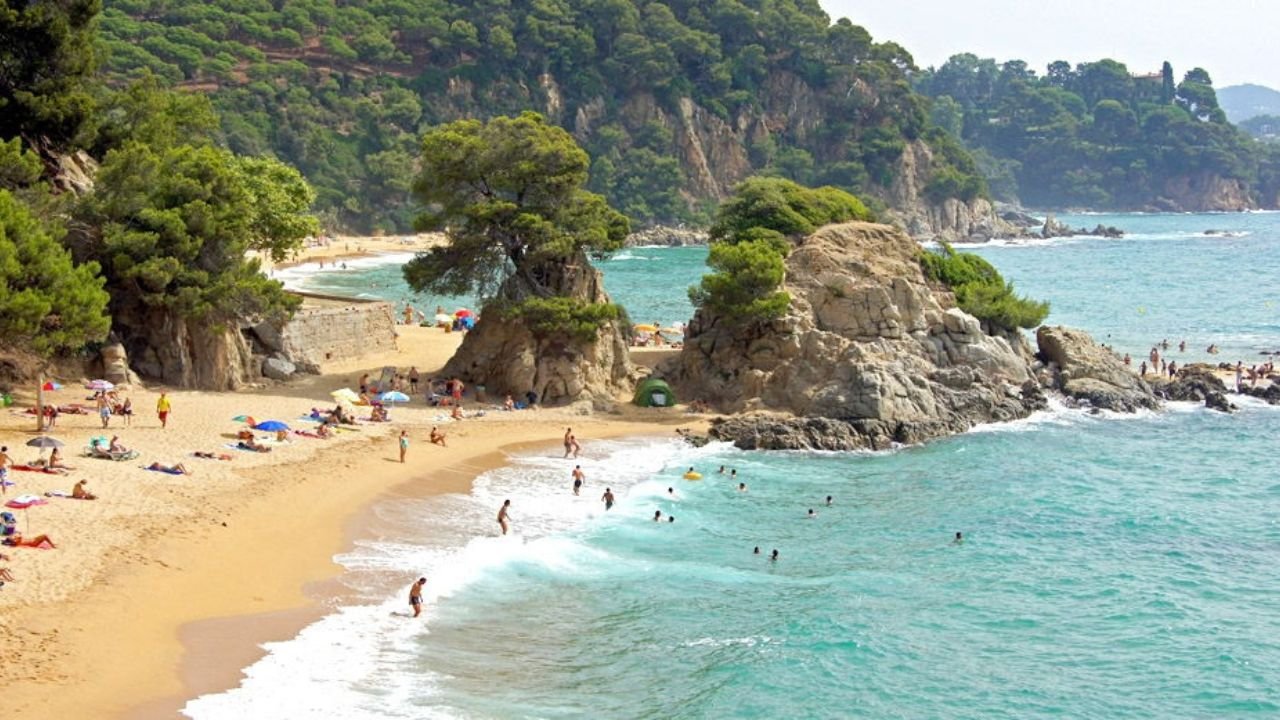The Costa Brava, stretching along 200km of Catalonia’s northeastern coast from Blanes to the French border, is a region of rugged cliffs, turquoise coves, and whitewashed villages that embody Mediterranean charm. Known as the “Wild Coast” for its dramatic landscapes, it blends natural beauty, rich history, and vibrant culture. This exploration highlights the region’s must-see towns, beaches, cultural landmarks, and activities, offering a guide to its diverse attractions.
Coastal Gems: Beaches and Coves
The Costa Brava’s coastline is its defining feature, with beaches and hidden coves that range from bustling resorts to secluded bays.
Iconic Beaches
- Sa Caleta, Lloret de Mar: A picturesque beach framed by a medieval castle, ideal for families with its shallow waters and vibrant promenade. Its golden sand and proximity to Lloret’s nightlife make it a lively spot.
- Cala Sa Futadera, Tossa de Mar: Known as the “300 Steps Beach” for its steep descent, this secluded cove offers crystal-clear waters and a serene escape, perfect for snorkeling.
- Platja de Roses: Located in the Bay of Roses, one of the world’s most beautiful bays, this wide, sandy beach is great for windsurfing and kitesurfing, with shallow waters suited for all ages.
Hidden Coves
- Cala Sa Tuna, Begur: A tiny, charming cove with clear waters and a small beach, surrounded by fishermen’s cottages. It’s accessible via the Camí de Ronda trail, offering a peaceful retreat.
- Cala Aiguablava, Begur: Renowned for its turquoise waters and fine sand, this cove is a snorkeler’s paradise, with nearby restaurants serving fresh seafood.
- Cala Pedrosa, Tamariu: A pebbled cove sheltered by pine trees, ideal for diving and kayaking, with a rustic charm that feels untouched by mass tourism.
The Camí de Ronda, a 40km coastal path, connects many of these coves, offering breathtaking views and access to secret beaches. Hiking sections of this trail, like the 12km stretch between Calella de Palafrugell and Llafranc, reveals dramatic cliffs and hidden calas.
Charming Towns and Villages
The Costa Brava’s towns and villages are a blend of medieval history, artistic heritage, and seaside allure, each with a distinct character.
Cadaqués
This whitewashed fishing village, nestled near Cap de Creus Natural Park, inspired Salvador Dalí. Its cobbled streets, vibrant art scene, and serene waterfront make it a cultural hub. Visit the Salvador Dalí House-Museum in Port Lligat to explore his quirky home, complete with egg-shaped sculptures. Cadaqués’ nightlife is lively yet relaxed, with beachfront bars and restaurants serving local seafood.
Tossa de Mar
Tossa de Mar combines a fortified medieval village, Vila Vella, with stunning beaches. The 12th-century walls offer panoramic views, while the old town’s cobblestone streets are lined with boutiques. The town’s history as an anti-bullfighting pioneer (declared in 1989) adds to its unique identity. Dine at Sa Barca for traditional seafood paella.
Begur
Perched on a hilltop, Begur boasts a ruined 15th-century castle and a colorful historic quarter. Its proximity to coves like Sa Tuna and Aiguablava makes it a perfect base. The town’s annual Indianos Fair celebrates its colonial ties to Cuba, with music and dance.
Pals
A medieval gem inland from Begur, Pals is a maze of cobbled streets, Gothic arches, and stone towers. Its 9th-century castle and panoramic views over rice paddies and vineyards create a timeless atmosphere. The nearby Ca la Pruna museum, in a 15th-century fortified house, showcases local history.
Calella de Palafrugell
This fishing village exudes authenticity with its white houses, narrow streets, and small harbors. Its beaches, like Platja de Port Bo, are ideal for kayaking and paddleboarding. The Cap Roig Botanical Gardens, hosting summer music festivals, add cultural flair.
Girona
Though inland, Girona is the gateway to the Costa Brava. Its medieval walls, Jewish Quarter, and Gothic Cathedral (featured in Game of Thrones) are highlights. The colorful Casas de l’Onyar, riverfront houses, create postcard-worthy views. Girona’s culinary scene, home to Michelin-starred restaurants like Celler de Can Roca, is a draw for foodies.
Cultural and Historical Highlights
The Costa Brava’s history spans prehistoric, Greek, Roman, and medieval eras, with cultural landmarks that tell its story.
Salvador Dalí’s Legacy
The “Dalí Triangle” is a must for art lovers:
- Dalí Theatre-Museum, Figueres: A surreal masterpiece housing Dalí’s eccentric works, topped with giant eggs.
- Salvador Dalí House-Museum, Port Lligat: His seaside home, filled with bizarre decor, reflects his creative mind.
- Gala Dalí Castle, Púbol: A medieval castle Dalí gifted to his wife, showcasing his devotion and art.
Historical Sites
- Empúries, L’Escala: The ruins of a Greco-Roman settlement, dating to the 6th century BCE, offer a glimpse into ancient trade. Walk through mosaics and amphitheaters by the sea.
- Sant Pere de Rodes Monastery: A 10th-century Benedictine monastery perched above Port de la Selva, with stunning views and Romanesque architecture.
- Vila Vella, Tossa de Mar: The only surviving fortified medieval town on the Catalan coast, with 14th-century walls and towers.
Festivals
The Costa Brava’s festivals celebrate its cultural diversity:
- Calonge Music Festival (August): The region’s oldest festival, featuring classical, flamenco, and jazz.
- International Fireworks Competition, Blanes (July): A dazzling display rivaling major global spectacles.
- Acústica Festival, Figueres (September): Showcasing emerging and established acoustic artists.
Activities and Adventures
The Costa Brava is a playground for outdoor enthusiasts and cultural explorers.
Water-Based Adventures
- Kayaking and Snorkeling: Explore hidden coves like those near Tossa de Mar or Calella de Palafrugell. Tours from Barcelona, like the Kayaking and Snorkeling Day Trip, include guides and gear.
- Boat Rentals in Blanes: Rent a motorboat (no license required) to discover inaccessible bays. Companies like Costa Brava Rent a Boat offer 2-8 hour trips.
- Scuba Diving: The Illes Medes, a protected marine reserve, is a top diving spot with vibrant marine life. PADI Discovery courses in Tossa de Mar cater to beginners.
Hiking and Cycling
- Camí de Ronda: This coastal trail offers hikes of varying lengths, from leisurely strolls to challenging treks. The section from Llafranc to Tamariu is family-friendly.
- E-Bike Tours: Explore the Baix Empordà’s medieval villages and vineyards on guided e-bike tours, covering 18 miles of scenic trails.
- Cap de Creus Natural Park: Hike through surreal rock formations that inspired Dalí, with trails leading to lighthouses and cliffside views.
Gastronomic Experiences
The Costa Brava’s cuisine is a fusion of sea and land. Try:
- L’Escala anchovies: Sample at beachside terraces or during the Anchovy Gastronomic Festival.
- Palamós prawns: Freshly caught and served in restaurants like Casa Juanita in Begur.
- Empordà Wine Route: Visit vineyards near Pals for tastings of tempranillo and grenache, some dating to the 5th century BCE.
Restaurants like Restaurant Cap de Creus, set in the natural park, offer seafood with cliffside views, though reservations are needed due to limited access.
Practical Tips for Exploring
- Best Time to Visit: June and September offer warm weather, fewer crowds, and lower hotel rates. July-August is peak season, ideal for swimming but busier. Spring (March-May) and fall (October-November) are great for hiking.
- Getting Around: Renting a car is recommended for flexibility, especially for rural areas and coves. Roads are well-maintained, and DiscoverCars offers competitive rates. Buses and trains connect major towns like Girona and Figueres, but schedules can be limited.
- Accommodation: Options range from luxury resorts in Tossa de Mar to boutique hotels like La Bionda in Begur or rural masias in Pals. Book early for summer.
- Duration: A 4-5 day trip allows exploration of Girona, a few coastal towns, and beaches. A week is ideal for a thorough visit, including inland villages and Dalí sites.
- Respect the Environment: Stick to marked trails, avoid littering, and follow local guidelines in natural parks like Cap de Creus.
Suggested Itinerary (5 Days)
- Day 1: Arrive in Girona. Explore the Jewish Quarter, Cathedral, and Casas de l’Onyar. Dine at a Michelin-starred restaurant.
- Day 2: Drive to Tossa de Mar. Visit Vila Vella, relax at Sa Caleta, and kayak to Cala Sa Futadera.
- Day 3: Head to Begur. Hike to Sa Tuna and Aiguablava coves via Camí de Ronda. Visit Pals’ medieval quarter in the evening.
- Day 4: Explore Cadaqués and Cap de Creus. Tour the Dalí House-Museum and hike to the lighthouse. Enjoy seafood at Restaurant Cap de Creus.
- Day 5: Visit Empúries ruins in L’Escala, then relax at Platja de Roses. Return to Girona or Barcelona.
Conclusion
The Costa Brava is a destination where rugged cliffs meet serene coves, medieval villages coexist with modern gastronomy, and Dalí’s surrealism blends with ancient ruins. Whether hiking the Camí de Ronda, snorkeling in turquoise waters, or wandering through Pals’ cobbled streets, the region offers an unforgettable mix of adventure and tranquility. Plan your trip to embrace its natural beauty, cultural richness, and Mediterranean lifestyle.

